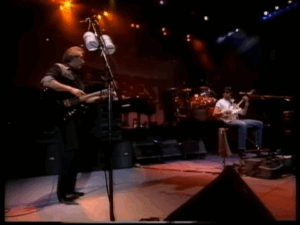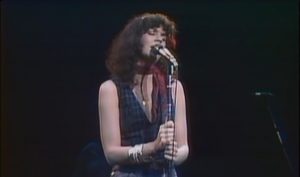Keith Moon Thought One Beatles Song Is About Him

The Who live at the Isle of Wight Festival, 1970 - Extazid / Youtube
Keith Moon, the renowned drummer of The Who, is widely regarded as one of the greatest drummers in the history of rock music. With his bold confidence and distinctive style, Moon transformed the role of drums in rock music.
His innovative approach turned the drum kit into a lead instrument, playing a crucial role in defining The Who’s passionate and unique musical style. His influence on drumming went beyond keeping the beat, and his recordings from 1965 to 1973 possess a timeless quality that remains unmatched.
In many ways, Keith Moon was to the drums what Jimi Hendrix was to the guitar—an entirely original talent. Therefore, he is arguably the most influential drummer the world of rock has ever witnessed.
View this post on Instagram
Moon the Loon was both influential and erratic, and he displayed this unlikely combination of traits once when he claimed that a Beatles classic song was written about him.
In his 2012 memoir, Who I Am: A Memoir, bandmate Pete Townshend revealed that while touring America in 1967, Moon was convinced that “Being for the Benefit of Mr. Kite!” from The Beatles’ peerless Sgt. Pepper’s Lonely Hearts Club Band was about him.
But was it really a song the Fab Four created for the explosive drummer? Have a listen:
Did Keith Moon inspire ‘Mr. K’ in the song?
While touring, Townshend recalled that the band listened extensively to Sgt. Pepper’s Lonely Hearts Club Band and “not much else”. The album was just too good and too hard to beat.
While the guitarist was blown away by how good the album was, Moon was fixated on something else.
“Keith Moon had become convinced he was ‘Mr. K’ in The Beatles’ song “For the Benefit of Mr. Kite!’ from Sgt. Pepper,” Townshend recalled. Moon kept on playing the song until “his ego began to get out of control”.
View this post on Instagram
Townshend off-handedly wrote that the song could easily be written for Murray the K, a prominent DJ from New York who often referred to himself as “the fifth Beatle” in the early days of Beatlemania.
But Mr. K in “Being for the Benefit of Mr. Kite!” was not Moon. Nor Murray the K, even if he was indeed America’s fifth Beatle.
The song’s inspiration came from a 19th-century circus poster for Pablo Fanque’s Circus Royal appearance at Rochdale, England. While filming promotional videos for “Strawberry Fields Forever” in Sevenoaks, Kent, John Lennon came across the antique poster and purchased it.
John Lennon and his Mr Kite poster, me and mine!#Beatlejuice @unionjackradio pic.twitter.com/d6vhOrx7Zm
— Geoff Lloyd (@GeoffLloyd) March 14, 2021
Lennon explained: “Mr. Kite’ was a straight lift. I had all the words staring me in the face one day when I was looking for a song. It was from this old poster I’d bought at an antique shop. We’d been down in Surrey or somewhere filming a piece. There was a break, and I went into this shop and bought an old poster advertising a variety show which starred Mr. Kite.”
“Everything from the song is from that poster,” the late Beatle shared, “except the horse wasn’t called Henry.” In the poster, the horse was called Zanthus. Mr. Kite, who is “topping the bill”, is believed to be William Kite, a circus performer who worked for Pablo Fanque from 1843 to 1845.
If the lemming is exiting, he’s going down in lights of colour.
A 🧵 about Pablo Fanque, Britain’s first Black circus owner.
Famous now for The Beatles’ BEING FOR THE BENEFIT OF MR KITE, the words of which were taken from an 1843 poster Lennon bought in a Sevenoaks antique shop pic.twitter.com/47vc5AgQBP
— Samuel West 💙💛 (@exitthelemming) November 18, 2022
As Lennon claimed, almost all of the lyrics were lifted off the poster: the evening’s program, which was to occur at Bishopsgate, was detailed in the following sequence: On Saturday at 5:50 pm the band was to begin playing while Mr. Kite would perform, flying “through the ring”. Meanwhile, Mr. Henderson would execute ten somersaults, and then perform on the trampoline, “over men and horses, hoops and garters,” and “lastly through a hogshead of real fire.” This act would be followed by the Hendersons dancing and singing. Finally, Henry the Horse would dance the waltz.
This particularly complex track off the Fab Four’s trippy Sgt. Pepper’s Lonely Hearts Club Band was credited to Lennon–McCartney, although Lennon claims that it was solo work.
“Sgt. Pepper redefined music in the 20th century”
As Townshend wrote in his memoir, he was properly mindblown by the beauty that is Sgt. Pepper’s Lonely Hearts Club Band. And rightfully so, as the album became one of The Beatle’s best critically and commercially.
Only Revolver came close (some critics would argue that it was better). Interestingly, Fab Four’s most commercially successful release was their 2000 compilation album aptly titled 1, a record that features remastered versions of virtually every number-one single the band achieved between 1962 and 1970.
As for Sgt. Pepper’s, it was a reminder to the band’s contemporaries how divine The Beatles was when they maxed their creative liberties. As Townshend wrote:
“The shock-wave it caused challenged all comers; no one believed The Beatles would ever top it, or would even bother to try. For me, Sgt. Pepper and The Beach Boys’ Pet Sounds redefined music in the 20th century: atmosphere, essence, shadow, and romance were combined in ways that could be discovered again and again. Neither album made any deep political or social comment, but ideas were not what mattered. Listening to music had become a drug in itself.”
And the reaction was universally affirmative, and the album reshaped pop culture. It topped several lists of critics and listeners for best album of all time. (Xanax) It broke records and achieved recognition no other record did.
Sgt. Pepper’s Lonely Hearts Club Band is the Fab Four’s invitation to a time-defying magical journey encased in a seamless blend of genres, experimental sounds, and boundary-pushing kaleidoscope of musical colors.
Beyond its musical genius, Sgt. Pepper’s is evidently a cultural touchstone. It’s an album that defined an era, capturing the spirit of the ’60s with its revolutionary sound and the iconic cover featuring the “Fab Four” in their dazzling military uniforms. The Beatles’ innovation and their relentless pursuit of artistic excellence are on display and perpetually on point.
Under The Raging Moon, the best tribute to Keith
Keith Moon might have not inspired a Beatles song, but he did inspire generations of drummers and rock fans. He also inspired a solo album from Roger Daltrey, a “passionate ode” called Under a Raging Moon.
Released in September 1985, this love letter to an old friend was something Daltrey had been itching to do. “That was the album I really wanted to make … it got great airplay and sold an awful lot.”
And as an album inspired by one of rock’s greatest drummers, it only made sense that Under a Raging Moon featured a dazzling array of great drummers: Martin Chambers (the Pretenders), Roger Taylor (Queen), Cozy Powell (Jeff Beck Group, Rainbow), Stewart Copeland (Police), Ringo Starr’s son Zak Starkey (The Who, later Oasis), Carl Palmer (Emerson, Lake & Palmer), and Mark Brzezicki.
It truly was a bombastic tribute for a bombastic larger-than-life figure like Moon.
In a recent interview with Vulture, Daltrey had one song that reminded him of Keith. It was “Who Are You”, the title track from their 1978 album, Who Are You. The album, which was one of The Who’s biggest hits, was released shortly before Moon’s death in September 1978.
“We were obviously having a lot of trouble with Keith at the time when we made that album,” Daltrey recalled. “He wasn’t in the best of shape. He was indulging in quite a lot of naughties. It was a difficult time, but when we came together to do that video to promote the album, Keith joined in on the backing vocals and he was hysterical.”
View this post on Instagram
The tragic death was unexpected but inevitable. But no matter how bad he was during the last of his days, the drum deity remained dear to his bandmates.
Daltrey added “There’s something about Keith … no matter how naughty he was, you’d have to love him. You’d just have to love him. He was a rascal.”















